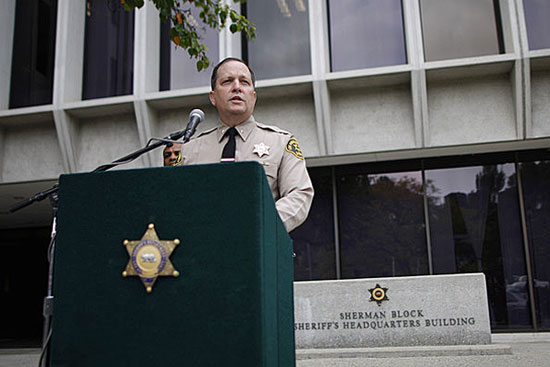Searching a web of clues
May 30, 2014

Scouring social media sites, sheriff's researchers have put a serious crimp in hundreds of teen parties.
There are no bigger party poopers in town than a tiny team of web savvy sleuths in the Sheriff’s Department, who patrol social media looking for potential trouble, including jammed-to-the-rafters raves that promise alcohol and drugs to underage partyers, particularly teenage girls.
During the past few years, the little-known unit has “intercepted” and helped block 1,000 parties before they even got started, according Cmdr. Mike Parker, the department’s leading authority on social media and online communications.
Sometimes, Parker said, deputies are dispatched directly to doorsteps, where they warn adults that they’ll be arrested for contributing to the delinquency of a minor should the party go off as advertised on Facebook, Twitter or other social media sites. Other times, the deputies will join an online conversation among would-be celebrants with this buzz-killing greeting: “Thanks for the invite. See you there!”
As a result, the department’s proactive Internet strategy has short-circuited the assaults and neighborhood disruptions that often accompany raves—and saved public dollars that otherwise would be spent on patrols and prosecutors.
“If it’s being shared for all the world to see,” Parker said of the party promotions and other postings that raise red flags about public safety, “then it’s the social equivalent of standing outside of school with a bullhorn. There’s no expectation of privacy. But if, as a law enforcement officer, you’re pretending to be someone else, that’s where you get into that danger zone of Big Brother accusations.”
The notion of proactively scouring the web for possible crime clues has emerged on the public radar in a very different context in recent days. In the aftermath of last Friday night’s Isla Vista murders, sheriff’s officials in Santa Barbara have been questioned about whether they should have known more about the killer with whom they’d had earlier contact and who had posted provocative videos and rants. Authorities there have acknowledged that, while they were aware of Elliot Rodgers’ videos, they did not view them.
In reality, most local police agencies have yet to explore the potential of the Internet as a preemptive crime-fighting tool, one that requires training and staffing, just like any other specialized law enforcement job, says Parker, who emphasizes that he is not second-guessing Santa Barbara police.
“It’s not like a 911 call that you’re obligated to respond to,” Parker said the other day, as he prepared to deliver a social media presentation at the county’s annual leadership conference. “It’s a very different challenge. You have to go out and hunt, and you have to want to do it. You have to pride yourself on finding things.”
Parker, a 29-year-veteran of the department, is a nationally-recognized leader of that effort. Until his recent promotion as commander of the north county patrol division, he headed the Sheriff’s Headquarters Bureau, which included the new Electronic Communications Triage Unit. Today, he’s its consultant and evangelist.
The unit has two full-time members and some part-timers whose web work extends far beyond raves. Using “keyword” and “geo-tag” searches, they target issues that could touch a broad swath of society or a single family—from preparing for a flash mob that’s been promoted online to trying to rescue a suicidal teenager. Parker shared this story:
After an assault with a deadly weapon occurred in a particular neighborhood, one of the unit’s members began searching the web for postings by witnesses that deputies could interview. In the process, she discovered a posting by a neighborhood girl who was threatening to take her own life. She’d posted pictures on Instagram and revealed she’d been cutting herself.
A street sign in the background of one of the photos allowed deputies to zero in a possible home. On the first visit, no one answered. The second time, mother and daughter were both there, Parker said.
“That’s when the mom found out that her girl was cutting herself and wanted to kill herself,” he said, adding that the mother knew her teen was depressed but did not understand the depth of her despair. The girl was voluntarily admitted for mental health care.
Asked whether the deputies’ intrusion into the girl’s life could be seen as a breach of her privacy rights, Parker responded:
“A key element is that she is sharing what she is doing for the entire world to see, including a potential predator, who would see her vulnerability as something to exploit. Psychologists would call her actions an open cry for help. We heard her cries and came to help. Too often, people are afraid to get involved…and sadness and regret often follow.”
“We could probably keep someone busy fulltime just working on people who want to hurt themselves,” Parker said.
Looking to an increasingly digital future, Parker said he believes that a robustly staffed regional center should be created to help law enforcement officers scour the web for open source material that could produce investigative leads at any time of day, just like other kinds of multijurisdictional task forces.
“As I say that, I know civil libertarians get concerned,” he admitted. But he argued that people put information into the public domain for the world to see—“and I’m a member of the world.”

Cmdr. Mike Parker has been leading the way in using the Internet to proactively identfy potential trouble.
Posted 5/30/14












 405 bridge work causes a stink
405 bridge work causes a stink
